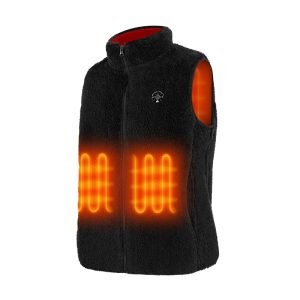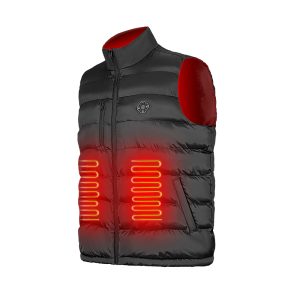Heated jackets offer remarkable warmth and convenience—but they’re not perfect. To make a well-informed choice, it’s important to understand their downsides. This article explores the potential disadvantages of heated jackets, backed by reputable sources, and illustrates how NRHEAT helps overcome many of these challenges through thoughtful OEM design and engineering.
1. Higher Initial Cost & Ongoing Expenses
Table of Contents
ToggleOne of the most cited drawbacks is the higher price tag. Heated jackets often cost significantly more than traditional outerwear due to integrated heating elements, batteries, and control systems. Over time, replacement batteries and chargers add to the total cost.
NRHEAT’s OEM advantage: Through scaled manufacturing and efficient design, NRHEAT enables brands to reduce per-unit costs while maintaining CE-certified production quality.
2. Battery Dependency & Limited Runtime
Heated jackets rely on rechargeable batteries. Running at high heat settings can drain them in just a few hours, limiting continuous use, especially on multi-day outings.
NRHEAT solution: Offers flexible battery configurations that support up to 12-hour runtime on low settings, dual-battery options, and fast-charging capabilities—ideal for extended use.
3. Maintenance & Washing Care
Caring for heated jackets requires extra attention: batteries must be removed before washing, wiring must remain intact, and drying should be gentle—all to avoid breaking heating functionalities.
NRHEAT’s approach: Implements integrated, durable wiring and provides clear cleaning instructions and durable construction to preserve longevity.
4. Uneven Heat Distribution
Some jackets only heat specific zones—like the chest or upper back—leaving other areas cool. Improper placement of heating elements can also result in uncomfortable pressure points.
NRHEAT innovation: Uses multi-zone carbon-fiber heating panels (including front, back, collar) with customizable layouts tailored to user activity or industry needs.
5. Bulky and Added Weight
The presence of batteries and heating components generally adds bulk and weight, which can hamper mobility—especially during active or technical activities.
NRHEAT response: Creates lightweight, ergonomic designs with slim batteries and flexible panels that maintain warmth without sacrificing mobility.
6. Safety Risks & Risk of Overheating
While most heated jackets include safety mechanisms like auto shut-off, users still face risks such as skin irritation, burns, or battery malfunctions if improperly used.
NRHEAT’s safeguards: Adheres to CE/FCC certification standards, integrates thermal cutoff systems, sealed circuits, and rigorous OEM-level testing protocols.
7. Limited Fashion Styles and Customization
Heated jackets often prioritize function, leaving less room for style or aesthetic variety. Many models follow utilitarian designs, which may not appeal to all consumers.
NRHEAT enables customization: Brands can leverage OEM flexibility to create fashionable patterns (urban, camo, workwear), custom branding, and unique styling while retaining heating functionality.
8. Technical Failures & Battery Safety Concerns
Heated jackets are electronics—they can suffer wiring damage, connector wear, or battery faults. Risk of electric shock or battery overheating exists if components degrade.
NRHEAT’s quality control: Ensures robust product build, strict safety compliance, and durable circuitry tailored for real-world use.
9. Dependence on Electric Power
Without battery power, the jacket loses its heating function. In remote settings or power outages, regular insulation may be more reliably warm.
NRHEAT’s mitigation: Offers longer-lasting battery options and rapid recharge capabilities—helping maintain heat even in power-limited environments.
Summary Table
| Disadvantage | Description | NRHEAT Mitigation |
|---|---|---|
| High Cost | Expensive initial and lifetime expense | OEM scale reduces costs, quality maintained |
| Battery Dependence | Limited runtime, heavier batteries | Improved runtime, dual batteries, fast charging |
| Maintenance Requirements | Delicate washing, handling | Durable wiring, clear care instructions |
| Uneven Heat Distribution | Incomplete or poorly placed heat zones | Multi-zone carbon-fiber elements, customizable layout |
| Bulk & Weight | Added heaviness hampers movement | Lightweight design, slim batteries |
| Safety Concerns | Risks of overheating, electric faults | ISO/CE/FCC certifications, thermal safety features |
| Style Limitations | Fewer fashion-forward options | OEM styling flexibility for diverse designs |
| Technical Failures | Electronics may fail over time | High-quality components, OEM reliability |
| Power Reliance | Non-functional without charged battery | Extended battery life, fast recharge options |
Final Thoughts
Heated jackets bring unmatched warmth and convenience, but they come with notable trade-offs: cost, maintenance, safety, and bulk. Recognizing these limitations empowers consumers to choose wisely.
Fortunately, advanced OEM manufacturers like NRHEAT bridge many of these gaps—reducing cost, improving safety, enhancing usability, and allowing customizable, sleek designs via their reliable manufacturing infrastructure.







